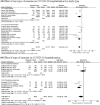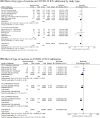Baseline physical activity is associated with reduced mortality and disease outcomes in COVID-19: A systematic review and meta-analysis
- PMID: 35416354
- PMCID: PMC9111124
- DOI: 10.1002/rmv.2349
Baseline physical activity is associated with reduced mortality and disease outcomes in COVID-19: A systematic review and meta-analysis
Abstract
Among coronavirus disease 2019 (COVID-19) patients, physically active individuals may be at lower risk of fatal outcomes. However, to date, no meta-analysis has been carried out to investigate the relationship between physical activity (PA) and fatal outcomes in patients with COVID-19. Therefore, this meta-analysis aims to explore the hospitalisation, intensive care unit (ICU) admissions, and mortality rates of COVID-19 patients with a history of PA participation before the onset of the pandemic, and to evaluate the reliability of the evidence. A systematic search of MEDLINE/PubMed, Cumulative Index to Nursing and Allied Health Literature, Scopus, and medRxiv was conducted for articles published up to January 2022. A random-effects meta-analysis was performed to compare disease severity and mortality rates of COVID-19 patients in physically active and inactive cases. Twelve studies involving 1,256,609 patients (991,268 physically active and 265,341 inactive cases) with COVID-19, were included in the pooled analysis. The overall meta-analysis compared with inactive controls showed significant associations between PA with reduction in COVID-19 hospitalisation (risk ratio (RR) = 0.58, 95% confidence intervals (CI) 0.46-0.73, P = 0.001), ICU admissions (RR = 0.65, 95% CI 0.52-0.81, P = 0.001) and mortality (RR = 0.47, 95% CI 0.38-0.59, P = 0.001). The protective effect of PA on COVID-19 hospitalisation and mortality could be attributable to the types of exercise such as resistance exercise (RR = 0.27, 95% CI 0.15-0.49, P = 0.001) and endurance exercise (RR = 0.41, 95% CI 0.23-0.74, P = 0.003), respectively. Physical activity is associated with decreased hospitalisation, ICU admissions, and mortality rates of patients with COVID-19. Moreover, COVID-19 patients with a history of resistance and endurance exercises experience a lower rate of hospitalisation and mortality, respectively. Further studies are warranted to determine the biological mechanisms underlying these findings.
Keywords: COVID-19; exercise; meta-analysis; physical activity.
© 2022 John Wiley & Sons Ltd.
Conflict of interest statement
The authors declare that there are no conflict of interests.
Figures







References
-
- Roser M, Ritchie H, Ortiz‐Ospina E, Hasell J. Coronavirus disease (COVID‐19)–Statistics and research. Our World in data. 2020;4.
-
- Parodi SM, Liu VX. From containment to mitigation of COVID‐19 in the US. JAMA. 2020;323(15):1441‐1442. - PubMed
-
- Khoramipour K, Basereh A, Hekmatikar AA, Castell L, Ruhee RT, Suzuki K. Physical activity and nutrition guidelines to help with the fight against COVID‐19. J Sports Sci. 2021;39(1):101‐107. - PubMed
Publication types
MeSH terms
LinkOut - more resources
Full Text Sources
Medical

